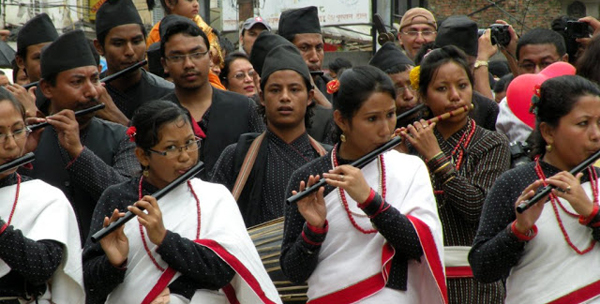|
The Kathmandu Valley and surrounding territories constituted the
former Newar kingdom of the Nepal Mandala.[11][12] Unlike other
common-origin ethnic or caste groups of Nepal, the Newars are
regarded as an example of a nation community with a relict
identity, derived from an ethnically-diverse,
previously-existing polity.[13] Newar community within it
consists of various strands of ethnic, racial, caste and
religious heterogeneity, as they are the descendants of the
diverse group of people that have lived in Nepal Mandala since
prehistoric times.
Indo-Aryan tribes like the Licchavis, Kosala,
and Mallas (N) from respective Indian Mahajanapada (i.e.
Licchavis of Vajji, Kosala, and Malla (I)) that arrived at
different periods eventually merged with the local population by
adopting their language and customs. These tribes however
retained their Vedic culture and brought with them their
Sanskritic languages, social structure and Hindu religion, which
was assimilated with local cultures and gave rise to the current
Newar civilisation.[4] Newar rule in Nepal Mandala ended with
its conquest by the Gorkha Kingdom in 1768.[14][15]
Newar
people (also known as Newars or Nepami) are the historical
inhabitants of the Nepal Mandala which consists of Nepa Valley
and its surrounding areas in Nepal and the creators of its
historic heritage and civilization.

Newar people have developed a division of labor and a
sophisticated urban civilization not seen elsewhere in the
Himalayan foothills. Newar people have continued their age-old
traditions and practices and pride themselves as the true
custodians of the religion, culture and civilization of Nepal.
They are the historical inhabitants of the Kathmandu Valley and
its surrounding areas in Nepal and the creators of its historic
heritage and civilisation. Newars form a linguistic and cultural
community of primarily Indo-Aryan and Tibeto-Burman ethnicities
following Hinduism and Buddhism with Nepal Bhasa as their common
language.
The Kathmandu Valley and surrounding territories constituted the
former Newar kingdom of the Nepal Mandala. Unlike other
common-origin ethnic or caste groups of Nepal, the Newar people
are regarded as an example of a nation community with a relic
identity, derived from an ethnically-diverse,
previously-existing polity. Newar civilization within it
consists of various strands of ethnic, racial, caste and
religious heterogeneity, as they are the descendants of the
diverse group of people that have lived in Nepal Mandala since
prehistoric times.
|

